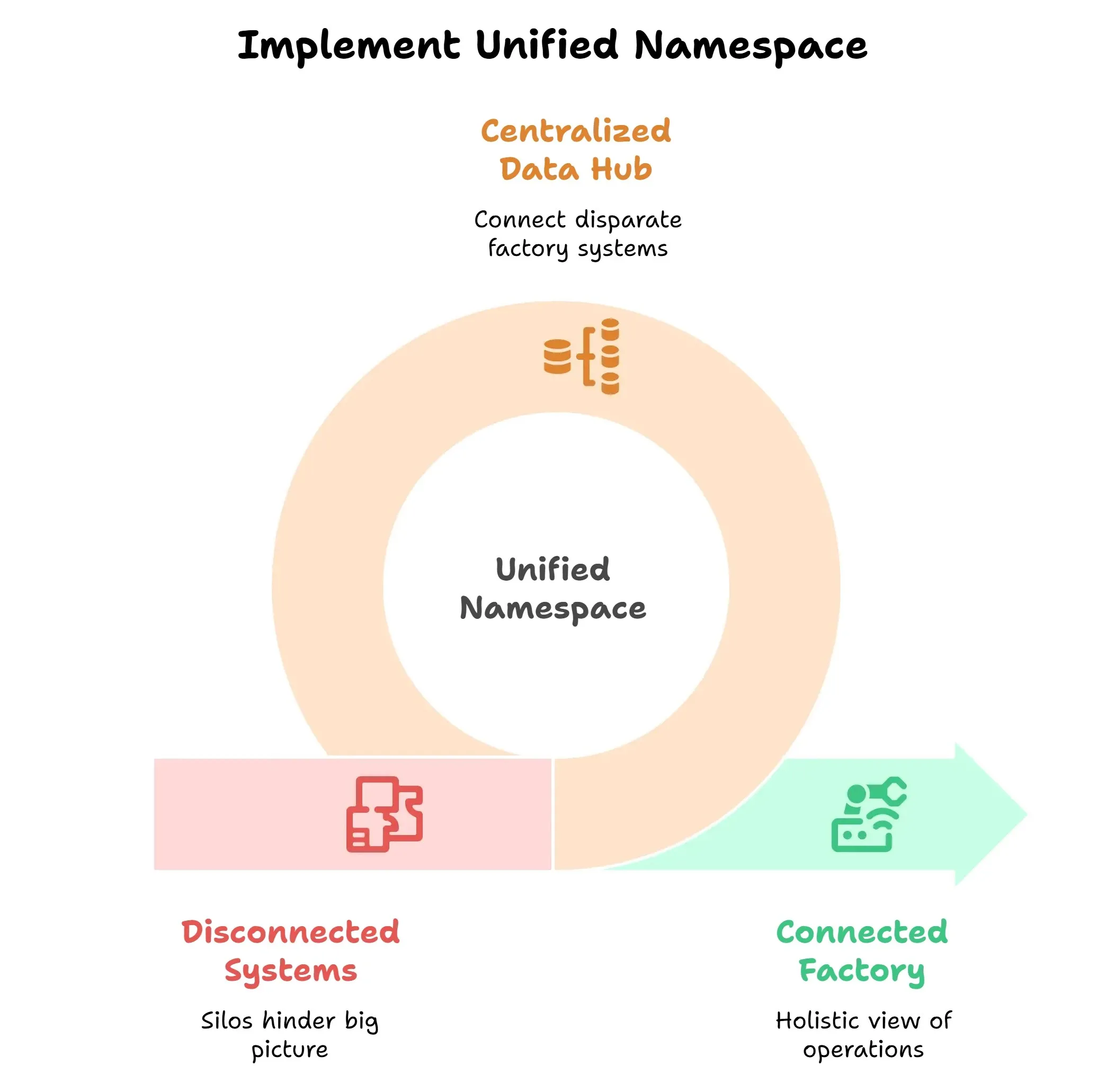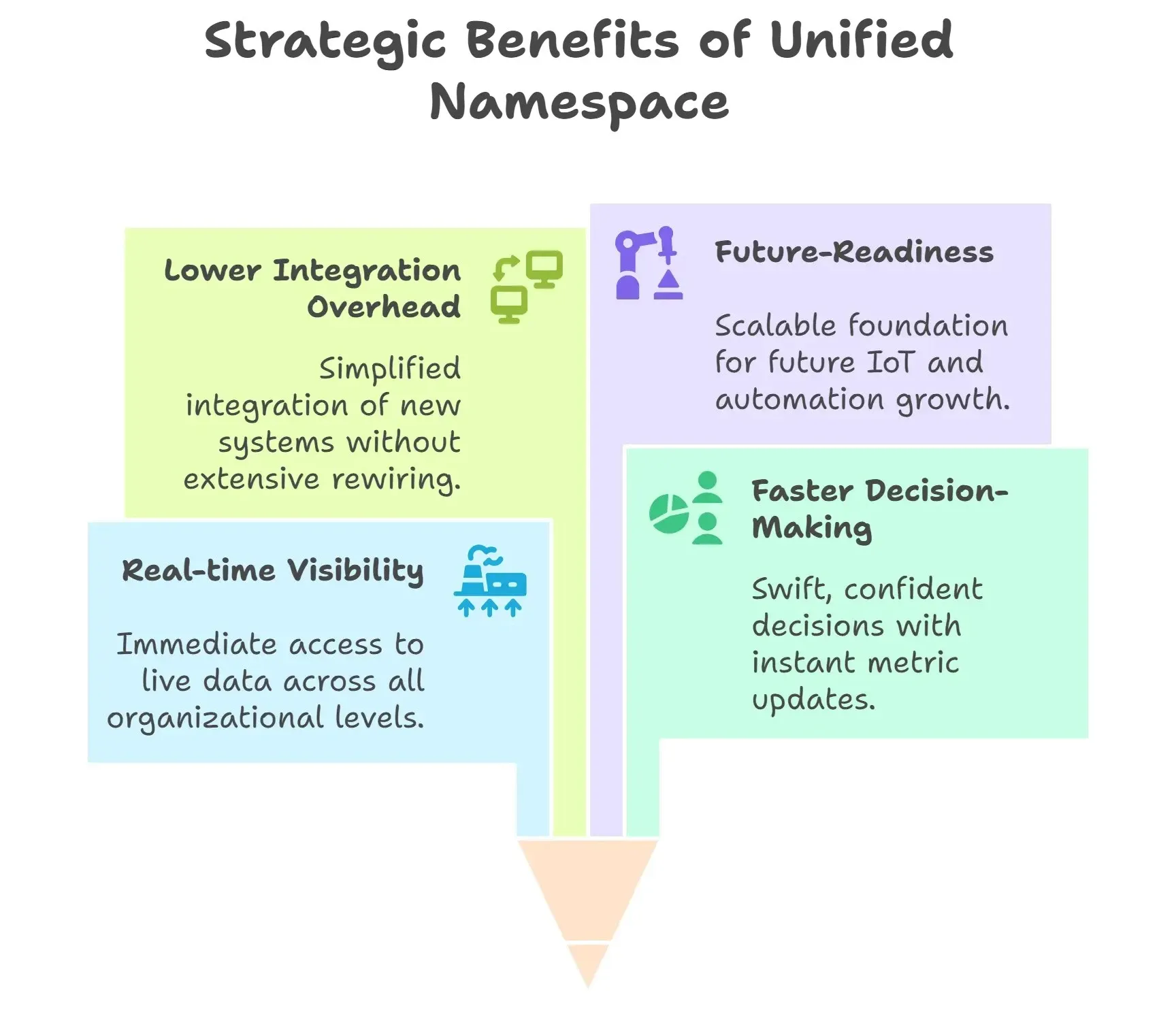In today’s manufacturing landscape, speed and precision are everything — but achieving both is increasingly difficult when your data lives in silos.
For decades, factories have relied on a patchwork of systems: SCADA, MES, ERP, QMS, custom dashboards, and more. Each does its job. But when it's time to see the big picture — to connect the dots between production, quality, and performance — things start to break down. Information is delayed. Teams work in isolation. Integrations multiply, and IT spends more time firefighting than innovating.
That’s the environment where Unified Namespace (UNS) is gaining traction. Not as a trend — but as a necessary evolution in how manufacturing teams manage and move data.

The Hidden Cost of Disconnected Systems
It’s easy to overlook the friction caused by disconnected systems, because it’s often baked into the daily routine. But take a step back, and the pattern is clear:
- Maintenance teams rely on one tool for asset data, while quality pulls reports from another.
- Engineers write custom scripts just to move data between machines and dashboards.
- When a line goes down or quality drops, it takes hours (or days) to uncover the root cause — because no single system holds the full story.
And every time a new machine is installed or a process changes, integration becomes a project in itself.
This complexity might be manageable in a single plant. But scale it across multiple lines, teams, or facilities — and the cracks start to show.
A Better Way to Connect: The Power of Unified Namespace
Unified Namespace offers a fundamentally different approach. Instead of point-to-point integrations between systems, UNS acts as a centralized, structured layer where all systems, machines, and users can publish and subscribe to real-time data — using a shared “language” that mirrors your factory’s layout.
But what makes UNS truly valuable isn’t just the architecture — it’s the strategic benefits it unlocks:
- Real-time visibility across the organization
Everyone — from the shop floor to the boardroom — works with the same live data stream. No delays, no duplicated efforts. - Faster, more informed decision-making
When critical metrics change, dashboards, alerts, and workflows are updated instantly — helping teams react with speed and confidence. - Lower integration overhead
With UNS, new machines and systems don’t require full-stack rewiring. They simply publish their data to the namespace and subscribe to what they need. - Future-readiness
As manufacturers adopt more IoT devices, analytics platforms, and automation tools, UNS provides the scalable foundation to support that growth — without increasing complexity.

What the Shift Looks Like in Practice
Forward-thinking manufacturers are already making this shift — and seeing real results.
A production team deploys a new vibration sensor on a critical asset. Instead of developing a custom interface, the sensor publishes its readings directly to the UNS. The maintenance team subscribes to that data and configures real-time alerts in their CMMS — no extra coding, no delays.
A quality manager notices a rising defect rate in finished goods. With a traditional system, this would take days to investigate. With UNS, they correlate real-time process data, machine performance, and inspection results — and identify a root cause within minutes.
An operations director wants a live, cross-plant dashboard. Instead of extracting data from five different systems, the dashboard connects directly to the UNS — providing a real-time, unified view across all sites.
These aren’t futuristic use cases. They’re happening today — made possible by removing the bottlenecks that traditional architectures create.
The Strategic Case for Making the Shift Now
The move to UNS isn’t about replacing everything you’ve built. It’s about connecting what you already have, in a smarter, faster, and more flexible way.
As global supply chains tighten, customer expectations rise, and talent becomes harder to find, the ability to act quickly — with full visibility — is becoming a competitive advantage. That’s why many manufacturers are rethinking their industrial data architecture to remove friction and move toward a more connected, real-time operation.
Manufacturers who continue to rely on fragmented systems risk being stuck in reactive mode: chasing data, missing opportunities, and struggling to scale.
UNS offers a way out. It empowers teams to align around a single source of operational truth, adapt to change with minimal disruption, and drive continuous improvement with confidence.

Final Thought: From Data Bottlenecks to Data Fluency
Every manufacturer today is collecting data. The question is — how easy is it to use?
Can your teams access what they need, when they need it, without calling IT? Can your systems react in real-time? Can you scale without re-architecting everything?
If the answer isn’t a confident yes, UNS might be the foundation you’ve been missing.
It’s more than a technical solution. It’s a shift toward data fluency — where your machines, systems, and people all speak the same language, in real time.
And that’s what forward-thinking manufacturers are betting on — not just to catch up, but to stay ahead.
